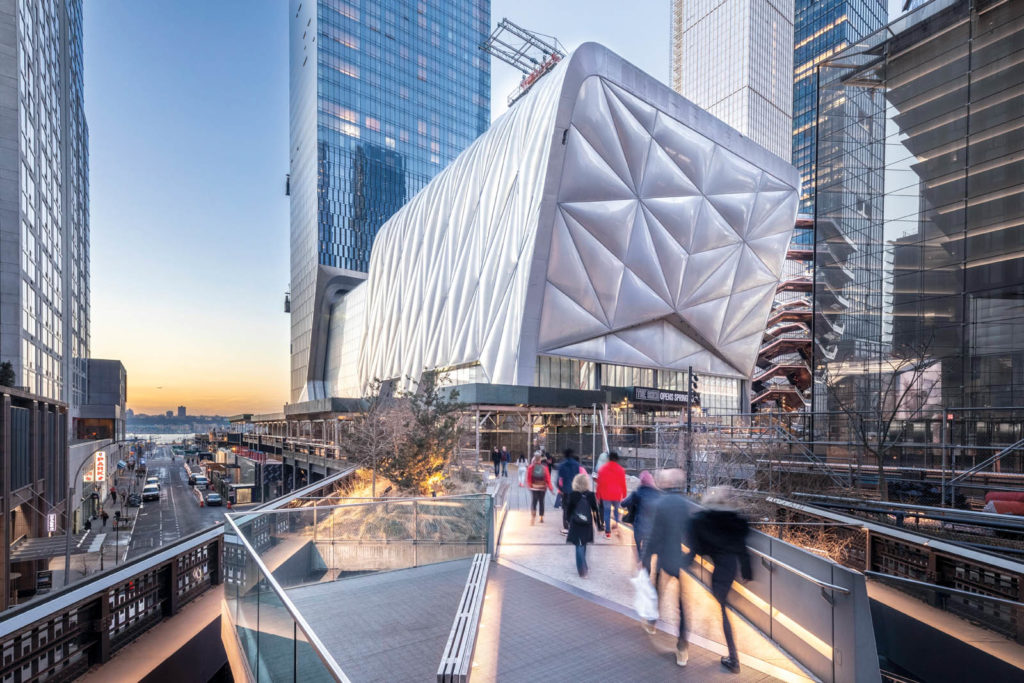Infrastructure and construction textiles succeed with a focus on sustainable alternatives.
By Seshadri Ramkumar and Marie O’Mahony

Today’s advanced textiles offer new forms for use in infrastructure projects and in building design and construction. These “hidden” textiles may be found in small-scale applications such as home furnishings as well as in huge projects such as road building. In many cases, sustainable options are growing, with novel advanced textiles taking the lead.
Flexible buildings
As technology has advanced and materials become lighter, buildings that actually move are becoming increasingly possible—and are attracting attention. Shape-shifting is not readily associated with a permanent building, but the recently opened The Shed arts center, which overlooks New York’s High Line, does just that. Designed by the architecture firm Diller Scofidio + Renfro (DS+R), which is also responsible for designing the High Line, the arts center has eight levels and houses performing and visual arts organizations as well as popular cultural events and creative spaces.
The need for flexibility has been transformed into the building’s own aesthetic. Ethylene tetrafluoroethylene (ETFE) pillows create a translucent telescopic outer shell that can be deployed to glide along rails to meet an adjoining plaza, effectively doubling the building’s footprint when it is needed for larger events. Power, lighting and theatrical rigging are all integrated into the soft structure held on a steel frame that acts as a skeleton.
The architects’ vision is for a building whose “open infrastructure can be permanently flexible for an unknowable future and responsive to variability in scale, media, technology and the evolving needs of artists.”
The inspiration came from the work of British architect Cedric Price and the influential Archigram Group, which conceived new forms of building and living in which programmable spaces could be introduced that would be changeable at the behest of occupants rather than prescribed by the designer or architect. In other words, a smart building.
Mediating technology
Part of an architect’s role has become mediating in the technological age so that the built environment can interface with its inhabitants. Dutch architect Ben van Berkel says the motivation behind the launch of his tech startup UNSense “is to use technology as a tool to make the built environment more humane and healthy on a physical, mental and social level.” The company is now putting this philosophy into practice in large and small-scale projects, including the RESET Stress Reduction Pods. Designed as an immersive modular structure, this series of break room “pods” features scientifically proven stress reduction methods within an office space where workers can take a “time-out.”
The soft environments measure an individual’s stress levels through wearable sensors that gather biometric information such as brain signals and heart rate. This information, coupled with the individual’s human movement, initiate changes in the pod’s spatial qualities using kinetic devices embedded in the textile walls. The sensors respond to an individual’s touch and biometric information with personalized image projections, colors and sounds designed to induce calm.
Monitoring at home
In home health monitoring, much of the focus has been on measuring the patient or elderly person’s physical well-being. As sensing and diagnostic capabilities have advanced, researchers are now looking at ways to introduce these to the smart home.
Acceptance of monitoring is important, so incorporating the technology within existing interiors and home furnishings has advantages. A favorite chair, for example, means the person can be monitored in a familiar place, and for the purpose of data collection, it also gives a more reliable reading.
Embedding sensors in smart cushions is showing positive results. At the Missouri University of Science and Technology,
Dr. Debraj De and Dr. Sajal K. Das have developed a Care Chair. It’s designed to monitor the daily behavior and mental health of rehabilitation patients as well as the elderly in their own homes or in assisted living facilities. Sensors embedded in a cushion that slips over the back of the chair are used to detect users’ emotional state through their activities. According to Dr. De, “When we move, subtle movements can indicate our mental state.”
Writing in the early part of the last century, Swiss-French architect, designer and urban planner Le Corbusier said, “The problem of the house is the problem of the epoch. The equilibrium of society today depends upon it.” He is now considered one of the pioneers of modern architecture. Technology has prompted innovations in building forms, improved safety, and brought added convenience and communication. The question that needs to be asked is, “‘Smart’ to what purpose?” Le Corbusier’s vision that architecture should engender a state of equilibrium in society is a good place to start.
New developments
With more awareness concerning the environmental and health issues, the textile industry has turned its focus to alternative materials for construction-related applications that are sustainable. For acoustic and insulation products, fiberglass high-loft nonwovens are typically used. With variables in toxicity for these and other construction materials, natural products are getting more attention.
The United States cotton sector has been a pioneer in looking into cotton as insulation mats for infrastructure and automobile applications. Waste and discounted (low micronaire) cottons are being exploited. The United States Department of Agriculture (USDA) laboratory in New Orleans has developed carded needle-punched fabrics from blends of natural fibers and synthetics. Results have shown that cotton nonwovens and polyurethane foams enhance the acoustic absorption capabilities of floor linings, showing that natural fibers can find industrial applications.
Similarly, with stringent end-of-life requirements in automobiles and other industrial products, more and more environmentally friendly materials for fibers and binders are being used. The Nonwovens and Advanced Materials Laboratory at Texas Tech University has investigated the possibility of using Texas coarse wool for weather and acoustic insulation products, creating value-added applications for natural fibers beyond their regular fiber-to-fashion supply chain.
An interesting project led by Professor Rajagopalan Vasudevan of Thiagarajar College of Engineering in Madurai, India, is utilizing recycled plastics and plastic waste as reinforcing materials in road construction. This project finds new applications for plastic, thereby reducing the environmental load. Plastic wastes are made into cost-effective road-building blocks. Several states in India are using the plastic “road blocks,” and countries such as The Netherlands are taking note of this development.
Cary, N.C.-based Cotton Inc. has been creating awareness about recycling denim by developing industrial products such as insulation through the Blue Jeans Go Green™ program, begun in 2006. Bonded Logic Inc. has been manufacturing these recycled denim insulation products, and according to the manufacturers, they are more efficient than conventional insulations mats.
Not only denim wastes, but carpet wastes have been repurposed—in this case for particle boards—through Carpet America Recovery Effort, headquartered in Dalton, Ga. The government of India enterprise has come up with glass fiber-reinforced gypsum wall board known as “Gypwall,” which has resulted in producing larger prefabricated panels for construction purposes.
The Mumbai, India-based Central Institute for Research on Cotton Technology (CIRCOT) has pioneered the development of particle board from cotton stalks. These have been used in walls, partition panels, insulation materials, artificial ceilings and other uses. According to CIRCOT, in India alone, 30 million tons of these agro-wastes are available, with the potential to be recycled into value-added products.
What’s next?
Natural fibers and environmentally friendly binders and chemistries must be exploited as a way forward in support of a more earth-friendly construction textiles sector. Additionally, processes and products must evolve that will bring down costs to ensure the support of institutional buyers, such as those in infrastructure, shipping and defense sectors.
The construction textiles sector should look into products beyond coated fabrics and geotextiles. Large-scale availability, government regulations, cost and consumer acceptance will be key factors in the immediate acceptability of emerging infrastructure textiles.
Marie O’Mahony is an industry consultant, author and visiting professor at the Royal College of Art (RCA), London.
Seshadri Ramkumar, Ph.D., is the director of the Nonwovens and Advanced Materials Laboratory, Texas Tech University.
The Blue Jeans Go Green™ program provides UltraTouch™ Denim Insulation to Habitat for Humanity buildings. Manufactured by Bonded Logic Inc., the insulation is made from post-consumer recycled denim and is environmentally safe, carrying no carcinogenic warnings, formaldehyde or chemical irritants. It has shown extraordinary thermal performance and 30 percent better sound absorption than traditional fiberglass insulation. It also contains an active mold and mildew inhibitor.
 TEXTILES.ORG
TEXTILES.ORG



